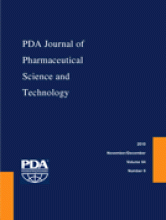Abstract
The concept of quality by design (QbD) reflects the current global regulatory thinking related to pharmaceutical products. A cornerstone of the QbD paradigm is the concept of a design space, where the design space is a multidimensional combination of input variables and process parameters that have been demonstrated to provide the assurance of product quality. If a design space can be established for a pharmaceutical process or product, then operation within the design space confirms that the product or process output possesses the required quality attributes. This concept of design space can be applied to the safety (leachables) assessment of drug products manufactured and stored in packaging systems. Critical variables in such a design space would include those variables that affect the interaction of the drug product and its packaging, including (a) composition of the drug product, (b) composition of the packaging system, (c) configuration of the packaging system, and (d) the conditions of contact.
This paper proposes and justifies such a leachables design space for aqueous drug products packaged in a specific plastic packaging system. Such a design space has the following boundaries:
Aqueous drug products with a pH in the range of 2 to 8 and that contain no polarity-impacting agents such as organic solubilizers and stabilizers (addressing variable a).
Packaging systems manufactured from materials that meet the system's existing material specifications (addressing variable b).
Nominal fill volumes from 50 to 1000 mL (addressing variable c).
Products subjected to terminal sterilization and then stored at room temperature for a period of up to 24 months (addressing variable d).
The ramification of such a design space is that any drug product that falls within these boundaries is deemed to be compatible with the packaging system, from the perspective of safety, without the requirement of supporting drug product testing.
LAY ABSTRACT: When drug products are packaged in plastic container systems, substances may leach from the container and accumulate in the product. It is necessary that the drug product's vendor demonstrate that any such leaching does not occur to the extent that the leached substances adversely affect the product's safety and/or efficacy. One method for accomplishing this objective is via analysis of the drug product to identify and quantify the leached substances.
When a particular packaging system is utilized for multiple drug products, one reaches the point, after testing numerous drug products, where the leaching properties of the packaging system are well known and readily predictable. In such a case, testing of additional products in the same packaging system produces no new information and thus becomes redundant and unnecessary.
The quality by design (QbD) principle can be simply stated as follows: once a system has been tested to the extent that the test results are predictable, further testing can be replaced by establishing that the system was operating within a defined design space. The purpose of this paper is to demonstrate the application of QbD principles to a packaging system that has been utilized with over 12 parenteral drug products. The paper concludes that the leachables profile of all drug products that fit a certain description (the design space) is known and predicable.
- © PDA, Inc. 2010
PDA members receive access to all articles published in the current year and previous volume year. Institutional subscribers received access to all content. Log in below to receive access to this article if you are either of these.
If you are neither or you are a PDA member trying to access an article outside of your membership license, then you must purchase access to this article (below). If you do not have a username or password for JPST, you will be required to create an account prior to purchasing.
Full issue PDFs are for PDA members only.
Note to pda.org users
The PDA and PDA bookstore websites (www.pda.org and www.pda.org/bookstore) are separate websites from the PDA JPST website. When you first join PDA, your initial UserID and Password are sent to HighWirePress to create your PDA JPST account. Subsequent UserrID and Password changes required at the PDA websites will not pass on to PDA JPST and vice versa. If you forget your PDA JPST UserID and/or Password, you can request help to retrieve UserID and reset Password below.






